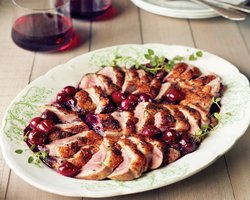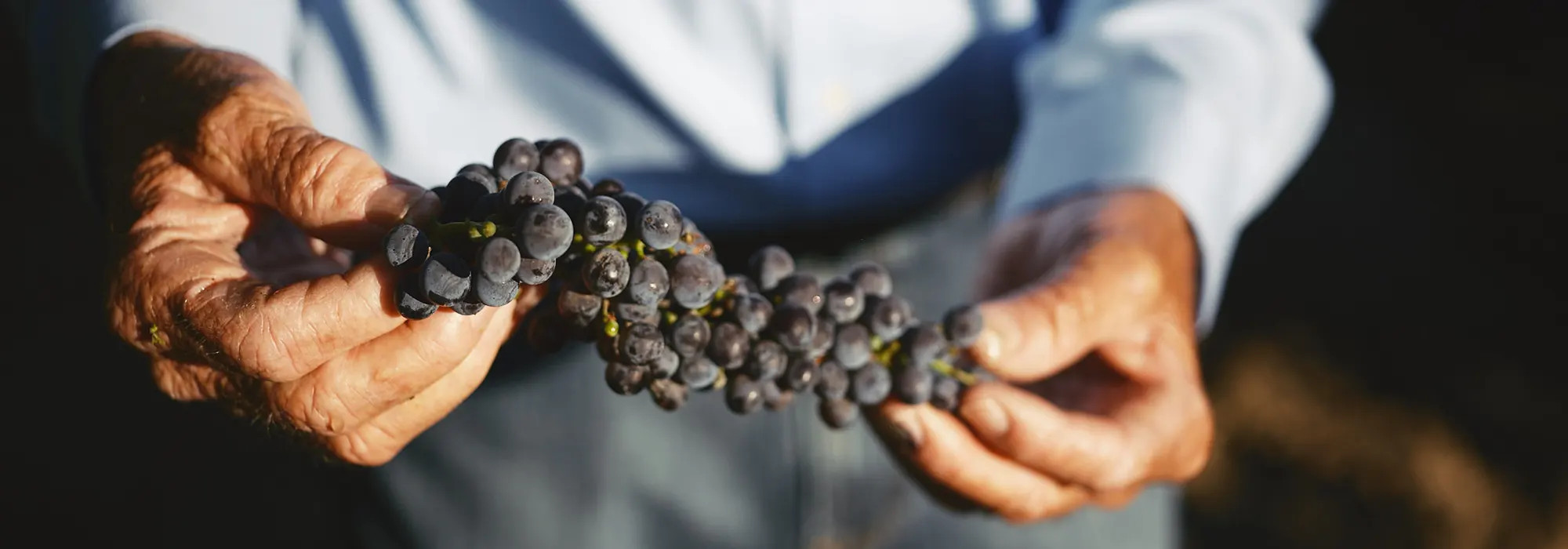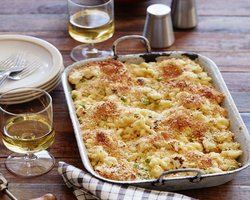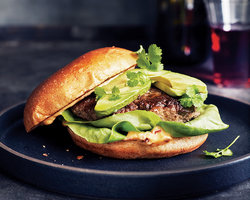SEARED DUCK BREASTS WITH PORT AND CHERRY SAUCE

Cooking duck breasts slowly, skin side down, helps eliminate almost every speck of fat. After about 20 minutes, the skin will be crisp and the flesh as rosy and tender as a fine steak. A silky port and cherry sauce makes this a restaurant-caliber dish. Serve with wild rice and your favorite Temecula Valley Cabernet Sauvignon or Merlot. Serves 4
Ingredients
Seasoning Rub:
8 juniper berries
2 teaspoons minced fresh thyme
2 teaspoons kosher or sea salt
1 teaspoon black peppercorns
4 boneless duck breasts, about 1⁄2 pound (250 g) each
Sauce:
1 cup (250 ml) Zinfandel Port or Ruby Port
1 shallot, minced
3 fresh thyme sprigs
1 strip orange zest, removed with a vegetable peeler
1 tablespoon balsamic vinegar
24 cherries, pitted and halved
1⁄2 cup (125 ml) strong chicken broth, reduced from 1 cup (250 ml)
1⁄2 teaspoon sugar
Kosher or sea salt and freshly ground black pepper
1 tablespoon unsalted butter
Directions
Make the seasoning rub: Put the juniper berries, thyme, salt, and peppercorns in a mortar or spice grinder and grind to a powder. Duck breasts vary tremendously in size; scale up the spice rub if the breasts you buy are considerably larger.
Slash the skin of each breast in a crosshatch pattern, stopping short of the flesh. (The slashes help render the fat.) Sprinkle the seasoning rub evenly onto both sides of each breast. Put the breasts on a flat rack and set the rack inside a tray. Refrigerate uncovered for 24 to 36 hours. Bring to room temperature before cooking.
Choose a heavy frying pan large enough to accommodate all the duck breasts comfortably. (If necessary to avoid crowding, use two frying pans.) Put the breasts, skin side down, in the unheated frying pan and set over medium-low heat. Cook until the skin is well browned and crisp, about 15 minutes, frequently pouring off the fat until the skin no longer renders much. (Reserve the fat for frying potatoes, if you like.)
Turn the duck breasts and continue cooking flesh side down, turning the breasts with tongs to sear all the exposed flesh, until the internal temperature registers 125°F (52°C) on an instant-read thermometer, about 3 minutes longer. Transfer the breasts to a cutting board and let rest for 5 minutes before slicing.
While the duck cooks, make the sauce: In a small saucepan, combine the port, shallot, thyme, orange zest, vinegar, and half of the cherries. Bring to a simmer over medium heat and simmer until reduced to 3∕4 cup (180 ml). Add the broth and sugar and simmer until the liquid has again reduced to 3∕4 cup (180 ml). Remove from the heat and, with tongs, lift out the thyme sprigs and orange zest and discard.
Puree the sauce in a blender. Set a very fine-mesh sieve over the saucepan and pass the sauce through the sieve, pressing on the solids with a rubber spatula. Return to medium heat, season with salt and pepper, and simmer until reduced to 1∕2 cup (125 ml). Stir in the remaining cherries and remove from the heat. Add the butter and swirl the saucepan until the butter melts.
Slice the duck on the diagonal. Spoon some of the sauce on each of four dinner plates, dividing it evenly. Top with the sliced duck. Serve immediately.
Suggested Pairings:
Baily Winery 2015 Estate Cabernet Sauvignon – Offers warm, rich tones with subtle, herbaceous qualities and a hint of mint.
Leoness Cellars 2016 Cellar Selection Cabernet Sauvignon – Bursting with aromas of black currant, blackberry and boysenberry fruit layered with subtle notes of vanilla, black licorice and sweet oak.
Maurice Car’rie Vineyard & Winery – Van Roekel Estate 2014 Merlot – Brings cherry, clove and cinnamon on the nose, with subtle hints of orange blossom.
Thornton Winery 2014 Merlot – Cherry, black berry currant and blueberry notes along with a fruit-driven entry that is complemented by oak barrels from France, Eastern Europe and North America.
Recipe and photo courtesy of the Wine Institute of California





